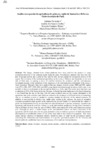Please use this identifier to cite or link to this item:
http://www.alice.cnptia.embrapa.br/alice/handle/doc/974089| Title: | Análise da expansão da agricultura de grãos na região de Santarém e Belterra, Oeste do estado do Pará. |
| Authors: | VENTURIERI, A.  COELHO, A. dos S.   THALES, M. C.   BACELAR, M. D. R.   |
| Affiliation: | ADRIANO VENTURIERI, CPATU; Andréa dos Santos Coelho, BOLSISTA CPATU/CNPQ; Marcelo Cordeiro Thales, MPEG; Maria Denise Ribeiro Bacelar, IBGE. |
| Date Issued: | 2007 |
| Citation: | In: SIMPÓSIO BRASILEIRO DE SENSORIAMENTO REMOTO, 13., 2007, Florianópolis. Anais... São José dos Campos: INPE, 2007. |
| Pages: | p. 7003-7010. |
| Description: | The images obtained from orbital platforms have been used for the analysis of many occupation processes of the Amazon region along the years. Nevertheless, analyses that have only one date of passage portray just a point in time and, for that, do not explain the occupation process of the region. The evolution of the mechanical agriculture in the towns of Belterra and Santarém, in the west side of Pará state, is causing a series of conflicts between the producers and the environmental movements because of the hypothesis of the expansion of the cultivated area in detriment of the areas of forest formation. Through a time series analysis that uses images from the sensors MSS and TM Landsat from 1975, 1986, 1997, 1999, 2004 and 2005, using digital classification and an intense field work, it was possible to observe the dynamic of the use and the discovery of the land. The results show that there was a reduction of 25% of the forest in the last 30 years. Although the main landscape is the forest formation, it was found that the use of the land with the most occupied area are the regions destinated to the agriculture and cattle activities and which are related to the producers of different levels of technology who try to combine a series of productive systems, aiming the diversity of the natural resources. In addition, it was possible to observe that, unlike other regions in the Amazon, the areas of secondary vegetation presented a high growth in the analyzed time period. Finally it is noticed that the culture of grains was implemented, mostly, in areas that were altered and used for pasture, secondary vegetation and agriculture and livestock activities (related to small and medium producers), having been converted a total of 435 km2 of forest from the year of 1999 to 2004, representing 8% of the total planted area in that year. Although we notice a smaller impact in the environmental context, the direct conversion of the agriculture and livestock class into the grain plantation seems to indicate a process of land concentration and migration of smallholder farmers to the urban areas and/ or new fronts of occupation. This social impact, already observed in Santarém suburbs, should be object of study for the government, mainly concerning the elaboration and implementation of a specific agricultural politics for the Amazon and should enable the smallholder farmer the maintenance of his land and food production. |
| Thesagro: | Sensoriamento Remoto |
| NAL Thesaurus: | Amazonia |
| Keywords: | Cultura de grãos |
| Type of Material: | Artigo em anais e proceedings |
| Access: | openAccess |
| Appears in Collections: | Artigo em anais de congresso (CPATU)  |
Files in This Item:
| File | Description | Size | Format | |
|---|---|---|---|---|
| 70037010.pdf | 262.68 kB | Adobe PDF |  View/Open |









